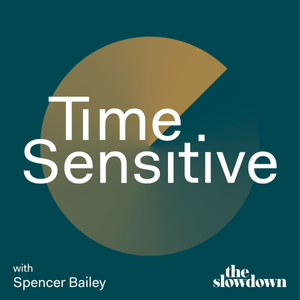
Time Sensitive
The Slowdown
1 Listener
All episodes
Best episodes
Seasons
Top 10 Time Sensitive Episodes
Goodpods has curated a list of the 10 best Time Sensitive episodes, ranked by the number of listens and likes each episode have garnered from our listeners. If you are listening to Time Sensitive for the first time, there's no better place to start than with one of these standout episodes. If you are a fan of the show, vote for your favorite Time Sensitive episode by adding your comments to the episode page.
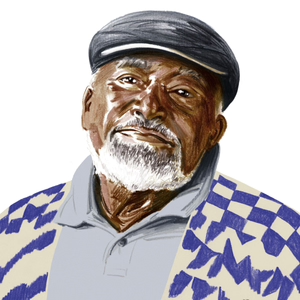
05/01/24 • 64 min
Born and raised in Pennsylvania, the 97-year-old Pittsburgh-based artist and sculptor Thaddeus Mosley has a deep and enduring obsession with wood. In his late 20s, he began to use the material for art, carving sculptures in his basement studio, and with his sculpture-making now spanning 70 years, his enduring dedication to his craft is practically unparalleled. Represented by Karma gallery since 2019, Mosley has only now, in the past decade or so, begun to receive the international recognition and attention he has long deserved. In his hands, wood sings; he shapes and carves trees into striking abstract forms that often appear as if they’re levitating while honoring and preserving their organic, natural character. As with the work of his two main influences, Constantin Brâncuși and Isamu Noguchi, Mosley, too, strives to make sculptures that, in his words, beyond today, “will be interesting in a hundred tomorrows.”
On the episode, he talks about the language that poetry, music, and sculpture all share; his early years as a sports writer for a local newspaper; and his life-transforming relationship with the Carnegie Museum of Art in Pittsburgh.
Special thanks to our Season 9 presenting sponsor, L’École, School of Jewelry Arts.
Show notes:
[4:13] Sam Gilliam
[17:24] Carnegie Museum
[21:08] Carnegie International
[21:08] Leon Arkus
[21:08] “Thaddeus Mosley: Forest”
[21:08] “Inheritance”
[24:20] Isamu Noguchi
[27:53] Constantin Brâncuși
[28:28] University of Pittsburgh
[28:28] Martha Graham
[46:15] Floyd Bennett Field
[46:23] Ebony magazine
[46:23] Sepia magazine
[46:23] Jet magazine
[46:23] Pittsburgh Courier
[54:34] John Coltrane
[51:37] Li Bo
[51:37] Dylan Thomas
[56:21] Bernard Leach
[57:45] Langston Hughes
[57:45] Countee Cullen
[57:45] Harriet Tubman
[57:45] Fannie Lou Hamer
[57:45] “The Long-Legged Bait”
[57:45] “Air Step - for Fayard and Harold Nicholas”
[57:45] The Nicholas Brothers
1 Listener
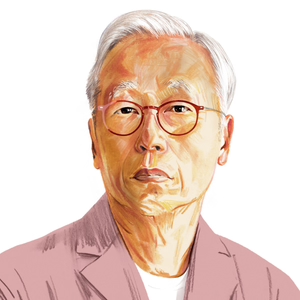
Hiroshi Sugimoto on Photography as a Form of Timekeeping
Time Sensitive
06/12/24 • 74 min
While he may technically practice as a photographer, artist, and architect, Hiroshi Sugimoto could also be considered, from a wider-lens perspective, a chronicler of time. With a body of work now spanning nearly five decades, Sugimoto began making pictures in earnest in 1976 with his ongoing “Diorama” series. In 1980, he started what may be his most widely recognized series, “Seascapes,” composed of Rothko-esque abstractions of the ocean that he has taken at roughly 250 locations around the world. In more recent years, Sugimoto has also built a flourishing architectural practice, designing everything from a café in Tokyo to the currently-under-construction Hirshhorn Sculpture Garden in Washington, D.C. As with his subtly profound work, Sugimoto bears tremendous wisdom and is regarded by many as one of the most deeply perceptive minds and practitioners at the intersection of time and art-making.
On the episode, he discusses his pictures as fossilizations of time; seascapes as the least spoiled places on Earth; and why, for him, the “target of completion” for a building is 5,000 years from now.
Special thanks to our Season 9 presenting sponsor, L’École, School of Jewelry Arts.
Show notes:
[5:10] Pre-Photography Time-Recording Devices
[39:05] “Theaters”
[15:06] “Seascapes”
[32:31] “Diorama”
[17:16] Caspar David Friedrich
[25:14] Odawara
[28:52] “Aujourd’hui le monde est mort [Lost Human Genetic Archive]”
[44:19] “Abandoned Theaters”
[44:19] “Opera Houses”
[44:19] “Drive-In Theaters”
[49:52] “Architecture”
[51:12] Le Corbusier
[51:12] Mies van der Rohe
[55:30] New Material Research Laboratory
[55:30] Tomoyuki Sakakida
[59:23] Enoura Observatory
[59:23] Hirshhorn Sculpture Garden
[1:00:48] Katsura Imperial Villa
[1:01:05] Bruno Taut
[1:02:14] Donald Judd
[1:02:14] “Hiroshi Sugimoto: Five Elements in Optical Glass”
[1:06:47] Mingei
[1:06:47] Isamu Noguchi
[1:06:47] Dan Flavin
[1:09:15] Sugimoto Bunraku Sonezaki Shinju: The Love Suicides at Sonezaki
[1:09:15] At the Hawk's Well
[1:09:15] W.B. Yeats
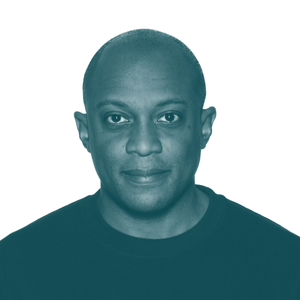
12/07/22 • 63 min
The artist Hank Willis Thomas is a voracious reader, not only of books, but of the world around us—and particularly, of images. Through his practice, Thomas interrogates and investigates, probes and prods, and ultimately helps make sense of various strands of visual culture—advertising, photographs, videos, clothing and ephemera, monuments—to tell necessary stories and shape new forms of meaning and memory. While Thomas’s roots are in the medium of photography, his work also extends far into other realms, including sculpture and memorialization. A prime example of this and a collaboration with MASS Design Group is “The Embrace,” a memorial to the Rev. Martin Luther King Jr. and his wife, Coretta Scott King, that will be unveiled in the Boston Common in January 2023. Another is the Gun Violence Memorial Project, organized with the prevention organizations Purpose Over Pain and Everytown for Gun Safety, and also with MASS.
Central to Thomas’s art are the subjects of truth and reality (best illustrated by his traveling “Truth Booth” installation, which toured all 50 states in the lead up to the 2016 U.S. presidential election), how they’re shaped, and by whom. Many of Thomas’s more conceptual projects also tend to be collective. Most notable among these is For Freedoms, an artist-run coalition he co-founded in 2016 as a super PAC that serves as a platform for artists of all kinds to meaningfully contribute to public discourse and help raise political awareness in the United States.
On this episode of Time Sensitive, Thomas speaks with Spencer about identity as a figment of our imaginations, race as the “most successful advertising campaign” ever, and quilt-stitching as a metaphor for all that he does.
Special thanks to our Season 6 sponsor, L’ÉCOLE, School of Jewelry Arts.
- Hank Willis Thomas
- [06:36] “Remember Me”
- [06:56] “Digging Deeper”
- [12:12] MASS Design Group
- [15:27] “The Embrace”
- [18:02] “Raise Up”
- [19:27] Gun Violence Memorial Project
- [23:21] “Unity”
- [27:59] TED Talk: “A Mother and Son United by Love and Art”
- [38:31] “Along The Way”
- [39:08] “Branded”
- [39:08] “Unbranded”
- [39:08] “Rebranded”
- [39:23] “Absolut Power”
- [43:55] “A Place to Call Home”
- [44:01] “Question Bridge: Black Males”
- [47:00] “Truth Booth”
- [49:01] For Freedoms
- [49:01] “For Freedoms News”
- [58:46] “Guernica”
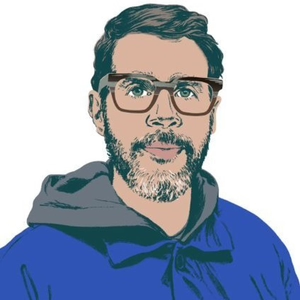
José Parlá on Coming Back to Life Through Art
Time Sensitive
07/26/23 • 74 min
Through his abstract paintings, the Miami-born, Brooklyn-based artist José Parlá explores themes ranging from memory, gesture, and layering, to movement, dance, and hip-hop culture, to codes, mapping, and mark-making. Coming up in Miami in the late 1980s and early ’90s, Parlá spent his adolescence and young adult years steeped in hip-hop culture and an underground scene that involved break dancing, writing rhymes, and making aerosol art. The art form still manifests, in wholly original ways, in his abstract works, which, while decidedly of the 21st century, extend in meaning and method back to ancient wall writings and cave drawings.
On the episode, Parlá talks about his recent near-death experience with Covid-19; his activism with the collective Wide Awakes; and how his large-scale murals at locations including the Brooklyn Academy of Music, Barclays Center, and One World Trade Center trace back to his early days of painting elaborate wall works with aerosol.
Special thanks to our Season 7 sponsor, Van Cleef & Arpels.
Show notes:
[07:37] Rey Parlá
[11:45] Ciclos: Blooms of Mold
[12:19] Augustin Parlá
[13:13] Curtiss School of Aviation
[14:05] José Martí
[16:20] “Phosphene” series
[18:27] “Polarities” series
[18:32] “Breathing” series
[23:25] Wide Awakes
[23:26] For Freedoms
[23:29] Hank Willis Thomas
[23:31] J.R.
[23:35] Wildcat Ebony Brown
[24:28] “The Awakening”
[32:04] “It’s Yours”
[34:17] Snøhetta
[34:45] Ghetto Gastro
[36:50] Craig Dykers
[36:55] José Parlá’s Studio
[38:20] James B. Hunt Jr. Library
[38:22] “Nature of Language”
[38:47] Far Rockaway Writer’s Library
[56:56] “Brothers Back to Back”
[59:51] “Parlá Frères”
[01:00:03] Hurricane Andrew
[01:00:12] Savannah College of Art and Design
[01:01:32] New World School of the Arts
[01:01:51] Mel Alexenberg
[01:02:29] “Combine” by Robert Rauschenberg
[01:06:29] “Gesture Performing Dance, Dance Performing Gesture” at BAM
[01:06:30] Barclays Center mural
[01:06:32] “One: Union of the Senses” at One World Trade Center
[01:06:33] “Amistad América” at the University of Texas at Austin
[01:12:08] Gordon Parks fellowship
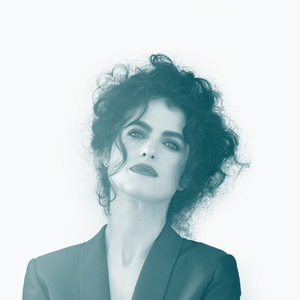
09/04/19 • 74 min
Neri Oxman is simultaneously a hardcore ecologist, evocative futurist, meticulous artist, and abstract scientist. The 43-year-old Israeli-American designer, architect, inventor, and MIT Media Lab professor embodies the same dualities that her work hinges upon. Oxman’s multifarious projects transcend the digital age; Oxman’s multifarious projects transcend the digital age; instead, she’s pioneering the “Biological Age” through “material ecology,” which fuses biology and technology, nature and culture, and the grown and made. Among her works are energy-generating photosynthetic wearables, a geometric dome spun by a robotic arm and completed by a swarm of silkworms, and sinewy masks modeled, in part, after the wearer’s own anatomical and physiological makeup—projects as functional and ideologically ambitious as they are beautiful.
Outstanding in their aesthetic rigor, Oxman’s brainchildren have caught the attention of leading museums, including New York’s Museum of Modern Art, the Centre Pompidou in Paris, and the Cooper Hewitt, Smithsonian Design Museum. This fall, she will receive SFMOMA's 2019 Contemporary Vision Award, and her next exhibition, “Material Ecology” at MoMA (on view from Feb. 22 to May 25, 2020), organized by Paola Antonelli and Anna Burckhardt, will present eight works from throughout her 20-year career—most notably an updated version of “Totems,” an array of vehicles for synthetically engineered melanin that debuted earlier this year in the Antonelli-curated “Broken Nature” exhibition at the Triennale in Milan.
Having pursued architecture after dropping out of medical school, Oxman went on to study at the Architectural Association in London and, later, at MIT, where after earning a Ph.D. she stayed on to become a professor and now leads the pathbreaking Mediated Matter group. On this episode of Time Sensitive, Oxman and Spencer Bailey delve into motherhood, “fossils of the future,” robotic queen bees, death masks, and more.
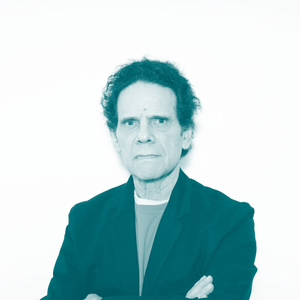
10/23/19 • 79 min
Daniel Brush’s acute eye for detail, as well as the rigor and vigor he brings to his craft, comes through loud and clear in all of his creations. A poet of materiality, he is at once a metalworker, a jewelry-maker, a philosopher, an engineer, a blacksmith, a painter, and a sculptor. The late Dr. Oliver Sacks, a friend of Brush’s, once said that Brush’s work is “the result of years of incubation, years of isolation and complete immersion, which have produced his unique and mysterious objects—they are made objects, and yet they seem found.” Sacks was not exaggerating when he said years. Brush’s oeuvre—on full display in the new Rizzoli book “Daniel Brush: Jewels Sculpture”—is the accumulation of four-plus decades of steadfast, heads-down, solitary work in his Manhattan studio, alongside his wife and accomplice, Olivia, allowing for only select visits from his closest friends and certain patrons, scholars, and students.
Brush’s imagination has always run wild—from his beginnings as a concert pianist in his youth, through his early years as a painter, to now, he has always demonstrated a rare intensity. For those who have laid eyes on his intricate cuffs, brooches, necklaces, and other pieces, it may be somewhat surprising to hear that it wasn’t until making a wedding ring for Olivia, in 1967, whom he had known for just three days before marrying, that he became interested in jewelry-making. Now, his work—colored by influences from a life of painting and drawing as well as his astute interests in Japanese Noh theater and Asian art—centers around jewels and objects made from a vast assortment of materials, including Afghan lapis lazuli, aluminum, amethyst, gold, Madagascar sapphire, malachite, steel, tektite, topaz, and tourmaline.
Brush, not surprisingly, also has a deep appreciation for history and collecting. His own made objects, as well as a large library of books and found objects, are stowed or situated around his home and studio, serving, for him, as a record of passing time. Given that his pieces are not traded on the market and rarely available to acquire, Brush’s work decidedly has, as he puts it, “no value.” Instead, he suggests that the value he derives from his work comes from the connections he has developed with patrons and peers who show respect for the complexity of it all. For Brush, it is the most minute connection—the tiniest detail—that so often reveals the largest truth.
On this episode of Time Sensitive, Brush’s use of language and storytelling approaches the poetic. He and Spencer Bailey talk about memory (and interpretations of memory); his deep, monkish engagement with a wide variety of materials; and some of his most valuable tools—breathing, language, and light.
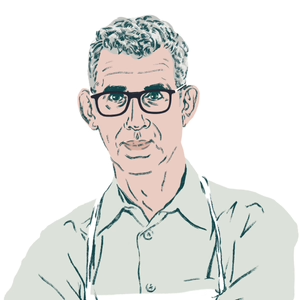
10/04/23 • 68 min
The London-based artist, master potter, and author Edmund de Waal has an astoundingly astute sense for the inner lives of objects. Each of his works, whether in clay or stone, is imbued with a certain alchemy, embodying traces of far-away or long-ago ancestors, ideas, and histories. This fall, two exhibitions featuring his artworks are on view at Gagosian in New York (through October 28): “to light, and then return,” which pairs his pieces with tintypes and platinum prints by Sally Mann, and “this must be the place,” a solo presentation displaying his porcelain vessels poetically arranged in vitrines, as well as stone benches carved from marble. As respected for his writing as he is for his pots, de Waal is the author of 20th Century Ceramics (2003), The Pot Book (2011), The White Road (2015), Letters to Camondo (2021), and, perhaps most notably, the New York Times bestseller The Hare with Amber Eyes (2010). All that de Waal does is part of one long continuum: He views his pots and texts as a single, rigorously sculpted body of work and ongoing conversation across time.
On this episode, de Waal talks about his infatuation with Japan, his affinity for the life and work of the Japanese-American artist Isamu Noguchi (1904-1988), and the roles of rhythm and breath in his work.
Special thanks to our Season 8 sponsor, Van Cleef & Arpels.
Show notes:
[00:28] Edmund de Waal
[03:43] Paul Celan
[08:12] 2023 Isamu Noguchi Award
[08:17] Gagosian
[08:20] “this must be the place”
[08:22] “to light, and then return”
[09:09] Twentieth-Century Ceramics
[09:20] The Pot Book
[18:23] “Letters to Camondo” Exhibition
[20:32] Sally Mann
[20:48] The Hare with Amber Eyes
[28:00] “The Hare with Amber Eyes” Exhibition
[30:56] “Playing with Fire: Edmund de Waal and Axel Salto” Exhibition
[40:24] Dr. Sen no Sōshitsu
[52:48] The White Road
[52:49] Letters to Camondo
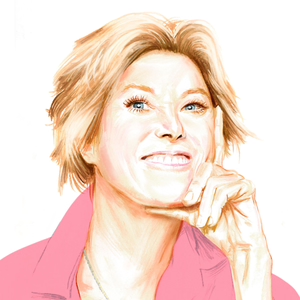
Edwina von Gal on Gardening as an Antidote
Time Sensitive
06/26/24 • 69 min
To the landscape designer Edwina von Gal, gardening is much more than just seeding, planting, weeding, and watering; it’s her life calling. Since starting her namesake firm in 1984 in East Hampton, on New York’s Long Island, she has worked with, for, and/or alongside the likes of Calvin Klein, Larry Gagosian, Frank Gehry, Maya Lin, Annabelle Selldorf, Richard Serra, and Cindy Sherman, creating gardens that center on native species and engage in other nature-based land-care solutions. In 2008, von Gal founded the Azuero Earth Project in Panama to promote chemical-free reforestation with native trees on the Azuero Peninsula. Stemming out of this initiative, in 2013, she then founded the Perfect Earth Project to promote chemical-free, non-agricultural land management in the U.S. Her most recent effort, Two Thirds for the Birds, is a call-to-action to plant more native plants and eliminate pesticides, thus creating a greater food supply for birds.
On the episode, she discusses the meditative qualities of gardening; reframing landscaping as “land care”; and why she sees herself not as a steward of land, but rather as a collaborator with it.
Special thanks to our Season 9 presenting sponsor, L’École, School of Jewelry Arts.
Show notes:
[15:32] William Cronon
[15:32] Changes in the Land
[15:32] Tiokasin Ghosthorse
[24:04] Carl Sagan
[24:04] The Demon-Haunted World
[26:07] Perfect Earth Project
[40:37] Two Thirds for the Birds
[42:41] John Fitzpatrick
[42:41] Cornell Lab of Ornithology
[42:41] Merlin Bird ID
[47:01] Garden Club of America
[50:21] Diana Vreeland
[51:09] Peter Sharp
[51:09] Channel Gardens at Rockefeller Center
[54:46] Frank Gehry
[54:46] Biomuseo
[54:46] Bruce Mau
[56:32] Azuero Earth Project
[1:00:37] Doug Tallamy
[1:02:01] Nature’s Best Hope
[1:05:12] The High Line
[1:05:12] Brooklyn Bridge Park
[1:05:12] The Battery Conservancy
[1:05:12] Brooklyn Museum
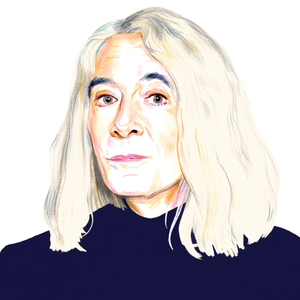
Lucy Sante on on Transitioning Into Herself at Long Last
Time Sensitive
04/03/24 • 58 min
Three years ago, at age 66, the Belgium-born writer and critic Lucy Sante—known for her award-winning essays, criticism, and books, including Low Life: Lures and Snares of Old New York (1991)—announced to a few dozen close friends that she was transitioning to womanhood. This news came following nearly four decades of publishing her work under the byline Luc Sante. In her new memoir, I Heard Her Call My Name (Penguin Press), which she discusses at length on this episode of Time Sensitive, Sante writes about the first six months of her recent transition, the decades-long silence that preceded it, and various piercing moments from her life that led up to it. She is also the author of books such as Nineteen Reservoirs (2022), The Other Paris (2015), and Folk Photography (2009), and her writing has appeared in publications including The New York Review of Books, The New York Times, Artforum, and Vanity Fair. Across all of her work, Sante brings a searing, no-nonsense clarity and a photographic eye for detail.
Also on this episode, Sante talks about why she thinks of the 1960s as “a kind of magic time,” her life-transforming literary journey, and her decision to open the floodgates of her womanhood.
Special thanks to our Season 9 presenting sponsor, L’École, School of Jewelry Arts.
Show notes:
[3:49] Lucy Sante
[3:49] I Heard Her Call My Name
[3:49] The Factory of Facts
[6:27] Nineteen Reservoirs
[6:27] Low Life
[9:28] Histories of the Transgender Child
[9:28] Jules Gill-Peterson
[22:11] Tintin
[24:07] Terry Southern
[24:07] Writers in Revolt
[24:07] Alexander Trocchi’s Caine’s Book
[24:07] Allen Ginsberg’s “Howl”
[24:07] Peter Orlovsky
[24:07] William Burroughs’s Naked Lunch
[24:07] Curzio Malapart’s Kaputt
[29:05] The New York Review of Books
[34:23] Folk Photography
[36:55] The Other Paris
[38:04] Walker Evans
[38:04] Robert Frank
[46:10] Maybe People Would Be the Times
[49:52] “The Invention of the Blues”
[51:41] The Velvet Underground
[51:41] Lou Reed
[51:41] Andrew Wylie
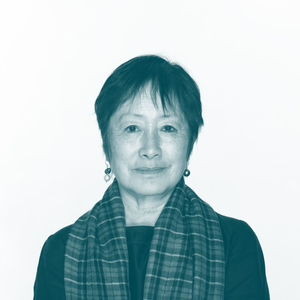
Billie Tsien on Imbuing Buildings With Feeling
Time Sensitive
04/28/21 • 85 min
Growing up in the 1950s in the only Chinese family in Berkeley Heights, New Jersey, Billie Tsien always felt like an outsider. She would seclude herself in the shower of her family’s home’s master bathroom, behind closed doors, escaping into books for hours before her parents, who had originally moved to America from Shanghai to study at Cornell, would find her. Through this Tsien developed a deep understanding of the value of a rich interior life—a concept she has gone on to apply to her work at the New York–based architectural practice Tod Williams Billie Tsien Architects Partners (TWBTA), which she co-founded with her husband, Tod Williams, in 1986.
The ethereal craft inherent in TWBTA’s structures, which include parks, libraries, museums, and other people-focused places, emanates from Billie and Tod’s belief that architecture is an act of service, and an opportunity to create quiet moments where visitors can indulge in the simple yet powerful emotions that can be stirred when encountering beauty. When Tsien, now 72, reflects on her firm’s philosophy—which entails making buildings that transcend solutions, that respect the earth, and that are measured by the lives lived within them—it’s clear that she profoundly, even poetically, shapes each project’s awe-inspiring energy.
Tsien’s deliberate, unhurried methodology is apparent in everything she does. She advocates for listening and community engagement—a central part of her firm’s high-profile, often controversial public works, such as Philadelphia’s Barnes Foundation (2012), Dartmouth College’s Hood Museum of Art (2019), and Chicago’s Obama Presidential Center, which is slated to break ground this fall. Tsien and her staff spend time with the craftspeople who create many of their materials—including Dutch textile artist Claudy Jongstra, whose vibrant felt paintings grace the walls of New York’s David Rubenstein Atrium (2009), and Danish brick-makers whose product features on the facade of dormitories at Pennsylvania’s Haverford College (2012)—and select them according to the emotional responses they elicit. She gives the same focused attention to the holistic experience of a building as she does the handrails that will go inside it. When it comes to the planet, Tsien thinks buildings should embrace measurable ways to minimize their environmental footprints as well as immeasurable ones, such as the meandering pathways of the LeFrak Center (2013), in Brooklyn’s Prospect Park, that invite people to appreciate the natural wonders around them.
On this episode, Tsien details the origins of and rationale behind her approach to the built environment, talking with Spencer about designing structures as containers for life, why history doesn’t unfold in a straight line, and architecture as both an honor and a responsibility.
Show more best episodes

Show more best episodes
FAQ
How many episodes does Time Sensitive have?
Time Sensitive currently has 134 episodes available.
What topics does Time Sensitive cover?
The podcast is about Culture, Society & Culture, Future, Nature, Podcasts, Time and Arts.
What is the most popular episode on Time Sensitive?
The episode title 'Thaddeus Mosley on Making Art to Be Appreciated for Centuries' is the most popular.
What is the average episode length on Time Sensitive?
The average episode length on Time Sensitive is 70 minutes.
How often are episodes of Time Sensitive released?
Episodes of Time Sensitive are typically released every 7 days.
When was the first episode of Time Sensitive?
The first episode of Time Sensitive was released on May 1, 2019.
Show more FAQ

Show more FAQ